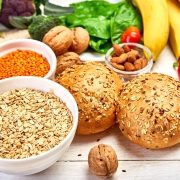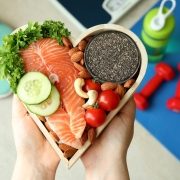10 Bright Ideas for Weight Loss
By Kahti Paydar, RDN | Registered Dietician
Are you finding yourself wanting to lose weight? Do you feel your weight loss New Year’s resolution got off to a late start? Believe it or not, there’s still time to achieve your health goals! Make small, gradual, and realistic changes that will build upon one another, creating a healthier future. Start today by reviewing these strategies to help you control your weight:
1. Think “choose well” not “diet.”
Instead of trying to starve yourself, choose foods that allow you to fill up on fewer calories. These are foods that are:
- Minimally processed
- High in fiber
- Low in fat and sugar
Examples include fruits, vegetables, cooked whole grains such as barley, oatmeal, buckwheat bulgur (cracked wheat), quinoa, millet, wild rice and brown rice and legumes for protein. Always pick leaner choices such as white breast meat of poultry (without skin), pork loin, lean beef (eye of round roast and steak, sirloin tip side steak, top round roast and steak, bottom round roast and steak, and top sirloin steak), legumes, and seafood. Prepare these items with little added fat.
2. Don’t skip breakfast.
Starting the day with a high fiber, low fat breakfast will help you consume fewer calories the rest of the day. Never skip breakfast!
3. Only eat when you are hungry.
Avoid eating to relax, cure boredom or overcome depression. These are emotions that trigger a desire to eat. Instead, brainstorm better ways to distract, calm, comfort, and nurture yourself without turning to food. Take a walk or call a friend.
4. Snack for better health.
- Snack only when hungry.
- Instead of packaged snacks, think “out of the bag” and enjoy fresh fruits and vegetables with low fat dips or fat-free, light yogurt. Baked potatoes, sweet potatoes and oatmeal also make great snacks.
5. Limit sugar & refined starch.
- Limit the amount of foods you eat that contain added sugars.
- Limit refined starch foods that are made with flour and are low in fiber. Fill up instead with high-fiber choices such as corn, potatoes, yams, lima beans, peas, dried beans, and whole grains.
6. Use less fat when cooking.
- Prepare foods using lower-fat cooking methods such as baking meats on a rack, broiling. Grilling, roasting or steaming instead of frying.
- Eliminate “extra” fats. Trim visible fats from meats. Rinse cooked ground meat. Remove skin from poultry.
7. Be a smart shopper.
- Avoid shopping when tired or hungry as that’s when you’re more likely to walk away with unnecessary impulse buys.
- Fill grocery carts 2/3 full of whole foods instead of convenience foods. These include fat-free dairy, fruits, whole grains, vegetables, seafood, chicken, and lean cuts of meat.
- Spend most of your time in the produce section of the store. Buy plenty of fruits and vegetables. Aim for 8-10 servings of fruits and vegetables each day.
- Follow these storage tips to keep produce fresh longer.
8. Be a little adventurous.
- Be adventurous and expand your range of healthful food choices.
- Buy a low-fat cookbook to help you modify traditional high-fat favorites, and to introduce quick healthful dishes.
9. Take care when eating out.
- When you eat out, choose soup and salad or smaller dishes that are low in fat.
- Ask for sauces and dressing on the side.
- If portions are large, take half home.
10. Try to make exercise fun.
- Take up several aerobic activities that are enjoyable, such as an aerobics class, walking, bike riding, swimming, running, hiking, tennis, softball, etc.
- Work out aerobically at least an hour a day, five or six days a week.
- Include weight lifting, also known as resistance training, three to four times a week.
- Celebrate your effort by determining the number of calories used in your workout.










